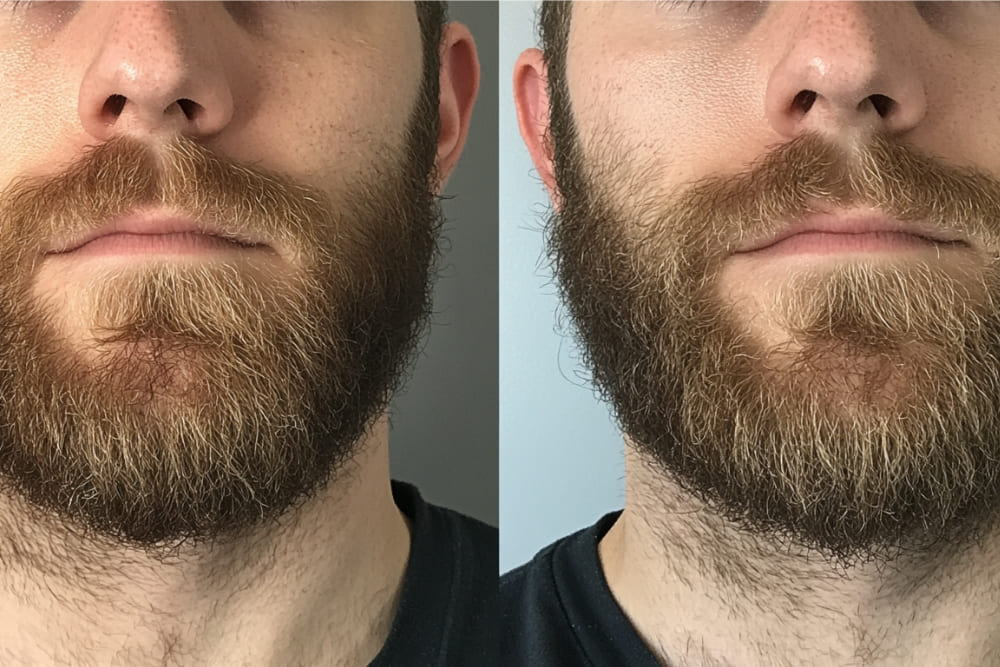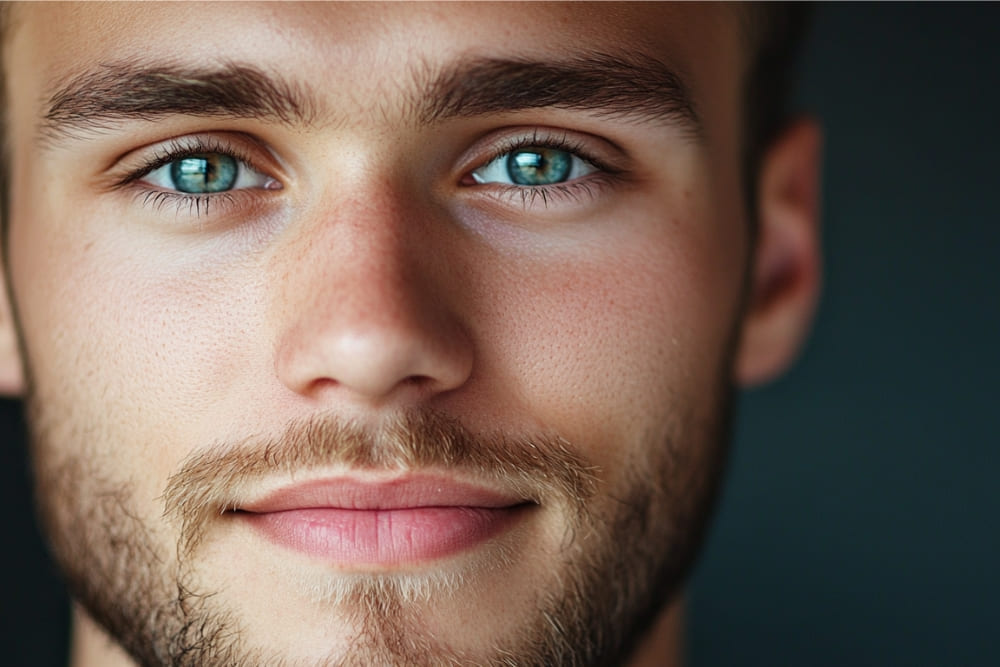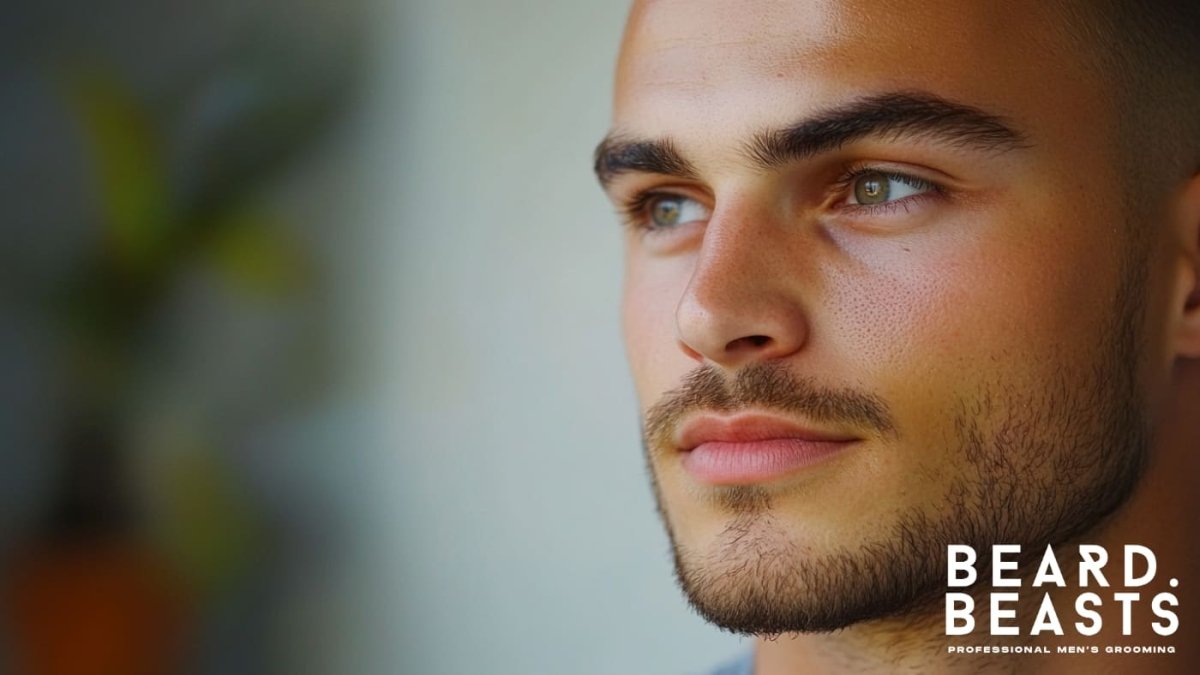A patchy beard is a common concern for many men, and it can impact both confidence and styling options. This guide offers practical advice on understanding the various causes of patchy beard growth.
We’ll cover effective care routines, styling techniques, and lifestyle adjustments to help you promote healthier facial hair development.
Understanding Patchy Beards
This section will help you understand what a patchy beard is, its common characteristics, and why so many men experience it.

What is a Patchy Beard?
If you’re wondering what a patchy beard actually is, it’s simply uneven or sparse facial hair growth, resulting in noticeable gaps or thin areas. It’s a common experience for guys of all ages, and factors like genetics, hormones, age, and lifestyle can all play a part.
Characteristics of Patchy Growth:
- Uneven Density: You might notice some areas growing thicker than others, creating an inconsistent look.
- Visible Gaps: These gaps often show up on your cheeks, jawline, or under your chin.
- Inconsistent Growth Patterns: Sometimes, growth is slow, and while some patches might fill in eventually, others might stay sparse.
Why Patchy Beards Are Common:
Patchy beard growth is especially common when you’re first starting to grow out your beard. Things like genetics, hormones, and age all influence how your facial hair develops. But remember, a patchy beard doesn’t mean you can’t rock a great beard style.
Plenty of styles, like stubble and goatees, look fantastic with natural growth patterns. Plus, with the right care and a bit of patience, you might even see those patchy areas fill in over time. Finding a style that works for your unique growth is key.
Causes of a Patchy Beard
Let’s dive into what actually causes a patchy beard. There are several things that can influence uneven facial hair growth, from your genes to your daily habits and even some underlying health conditions.
Genetic Predisposition:

Your genes play a big role in how thick and evenly your beard grows. If the men in your family tend to have patchy or sparse beards, you might be more likely to experience the same. While you can’t change your genetics, understanding this can help you focus on other ways to improve your beard, like proper grooming and styling.
Age and Maturation:
For many younger guys, a patchy beard is just a normal part of growing up. Facial hair often keeps developing well into your late twenties. So, if you’re in your teens or early twenties, patience is key. You might find your beard gets fuller naturally as you get older.
Hormonal Influences:
Testosterone and DHT (dihydrotestosterone) are key hormones for facial hair growth. If your testosterone levels are lower, it can lead to patchy growth or slower beard development. Regular exercise and a healthy diet can help support healthy hormone levels naturally.
Lifestyle Factors:

Your daily habits can also have a big impact on your beard’s health:
- Nutritional Deficiencies: Not getting enough key nutrients like Vitamin D, Biotin, and Zinc can weaken your hair follicles. Eating a balanced diet or taking supplements can help promote stronger growth.
- Stress: When you’re chronically stressed, it can actually disrupt your hair follicles, leading to slower growth or patchiness. Finding ways to manage stress, like exercise or relaxation techniques, can help.
- Grooming Habits: If you’re not taking good care of your beard, it can clog hair follicles and irritate your skin, which contributes to uneven growth. Washing your beard regularly with a mild beard shampoo, exfoliating, and moisturizing are important for keeping your follicles healthy.
Underlying Health Conditions:
While most of the time a patchy beard is nothing to worry about, sometimes it can be related to a health condition:
- Alopecia Areata: This is an autoimmune condition that can cause patchy hair loss, including on your face. If you think you might have this, it’s important to see a doctor.
When to Seek Medical Advice:
If your patchy beard suddenly gets worse, or if you have other symptoms like itching, redness, or hair loss on your scalp, it’s a good idea to see a dermatologist or other healthcare provider. They can help figure out if there’s an underlying medical issue.
In short, a patchy beard can be caused by a mix of genetics, hormones, lifestyle, and sometimes health issues. Knowing the potential causes can help you find the best way to improve your beard.
How to Fix a Patchy Beard
Dealing with a patchy beard can be a pain, but don’t worry – there are definitely things you can do to improve how it looks and encourage healthier growth. Here are some strategies to help you tackle those patchy areas:
Adopting a Healthy Lifestyle

Your overall health has a huge impact on how well your beard grows. Making a few key changes to your lifestyle can really boost the quality and consistency of your facial hair:
- Balanced Diet: Focus on eating foods packed with vitamins and protein, like lean meats, eggs, nuts, leafy greens, and fruits. Nutrients like biotin, zinc, and vitamin D are super important for healthy hair follicles and growth.
- Regular Exercise: Getting regular exercise, especially strength training, can give your testosterone levels a natural boost, which is key for beard growth. You can learn more about testosterone from the National Institutes of Health here.
- Adequate Sleep: Getting enough sleep helps your body regulate hormones (including testosterone) and repair cells, both of which are essential for consistent beard growth.
Establishing a Consistent Beard Care Routine
A solid grooming routine can make a big difference in how healthy and full your patchy beard looks:
- Regular Cleansing and Exfoliation: Wash your beard regularly with a gentle beard shampoo to get rid of dirt and oil. Exfoliate once or twice a week to help unclog those follicles and encourage growth.
- Application of Natural Oils: Oils like jojoba and castor oil can help hydrate your beard and might even wake up some of those dormant follicles. Massaging a few drops in daily can work wonders.
- Consistency is Key: Sticking to a consistent routine is really important for keeping the skin under your beard healthy, reducing irritation, and encouraging even growth.
Considering Beard Growth Products
If you’ve made changes to your lifestyle and grooming routine but still want more of a boost, you might consider using some specialized products:
- Growth Serums and Supplements: There are products out there with ingredients like minoxidil, biotin, and collagen that can potentially help with hair growth. Just make sure to follow the instructions carefully, and remember that it can take weeks or even months to see results.
- Appropriate Grooming Tools: Investing in good-quality tools like a beard comb and trimmer can really help you shape and style your beard to better blend those patchy areas.
Seeking Professional Advice
If you’re still having trouble or if you think there might be a medical reason for your patchy beard, it’s a good idea to talk to a professional:
- Dermatologists and Trichologists: These specialists can help identify any underlying issues, like skin conditions or hormonal imbalances, and recommend the right treatment plan for you.
- Advanced Treatments: There are also more advanced treatments like microneedling or PRP therapy that can stimulate your hair follicles and encourage thicker growth. These are worth looking into if other methods haven’t worked.
So, by combining a healthy lifestyle, a good grooming routine, and maybe even some professional help, you can definitely improve a patchy beard. Just remember that patience and consistency are super important!
Styling Tips for a Patchy Beard
If you’ve got a patchy beard, don’t worry – styling it the right way can make a huge difference. The trick is to work with your natural growth and use some smart grooming techniques to create a great look.
Choosing the Right Style

You don’t need a super thick, even beard to rock a cool style. Picking a style that complements how your beard naturally grows can minimize those patchy spots and really highlight your best features:
- Goatee or Stubble: These styles are great because they focus on the areas where you have more growth, like your chin and jawline. So, if your cheeks are a bit patchy, these are perfect options.
- Fades and Shaping: A fade from your beard down to your sideburns can create a really polished and intentional look, and it’s also a clever way to disguise any gaps. Using a good trimmer or visiting a barber can help you get those clean lines and balanced proportions.
It’s worth experimenting with different lengths and edges to see what looks best with your face shape and how your beard grows.
Strategic Grooming Techniques
There are also some specific grooming tricks you can use to make your beard look fuller, even if it’s a bit patchy:
- Uniform Trimming: Keeping your beard at a consistent length can make those patchy areas way less noticeable. Often, a shorter, well-maintained beard looks much fuller than a longer, uneven one. Using a good beard brush to train your hairs to grow in the same direction can also really improve how your beard looks overall.
Ultimately, confidence is what makes any beard style work. By embracing your unique growth and using these styling tips, you can actually turn those patchy areas into a part of your signature look.
Long-Term Growth Strategies
Growing a beard, especially if you’re dealing with some patchy areas, definitely takes time and a long-term approach. Consistent effort and keeping a positive attitude are key to getting the best results.
Understanding the Growth Timeline
Let’s be real: growing a beard isn’t going to happen overnight. It can take several months, or even longer, for your beard to fully fill in. Knowing this upfront will help you set realistic expectations and avoid getting discouraged.
- Consistent Growth Takes Time: A lot of guys get frustrated and give up too early because they don’t see results right away. But the truth is, it’s totally normal for patches to fill in slowly as those dormant hair follicles start waking up.
- Avoid Premature Actions: Try to resist the temptation to shave everything off or over-trim in the beginning. That old myth about shaving making your hair grow back thicker is just that—a myth. It just sets you back to square one. Stick with your routine and let your beard do its thing.
Tracking Your Progress
Keeping an eye on how your beard is developing can help you stay motivated and see what’s working for you:
- Document Your Growth: Taking photos regularly (like once or twice a week) is a great way to see those subtle improvements that you might miss day-to-day. These pictures can be a real confidence booster and show you how far you’ve come.
- Adjust Your Approach as Needed: Pay attention to how your beard reacts to different grooming products, changes in your diet, and other things you’re trying. If something’s not giving you the results you want, don’t be afraid to switch things up.
Maintaining a Positive Mindset
Just because you have a patchy beard now doesn’t mean you can’t have a stylish and confident look. Keeping a positive mindset will make the whole process much more enjoyable and something you can actually stick with:
- Focus on Personal Improvement: It’s easy to get caught up comparing your beard to other guys’, but everyone’s beard journey is different. Focus on making your own beard the best it can be.
- Build Confidence Through Consistent Effort: A well-groomed beard, even if it’s a little patchy, can still look great. Pairing that with some self-assurance will really elevate your whole look.
Bottom line: consistent effort, realistic expectations, and a positive attitude are what it takes to achieve the beard you’re after.
Conclusion: Embrace Your Patchy Beard
So, even if you’re dealing with a patchy beard, you can absolutely still achieve a well-groomed and stylish look. By understanding what causes patchy growth and putting the strategies we’ve talked about into action – from making healthy lifestyle changes and sticking to a solid grooming routine to using the right styling techniques – you can really make a difference in your beard’s appearance and overall health.
Just remember that growing a beard takes time. Patience and consistency are super important. Focus on what you can control: your diet, your grooming habits, and how you style your beard. These efforts, combined with a positive attitude, will help you work with your natural growth patterns and get a beard you’re proud to rock.
At the end of the day, confidence is what really makes any beard style work. Embrace your own beard journey, and let even your patchy beard be a reflection of your unique style.





